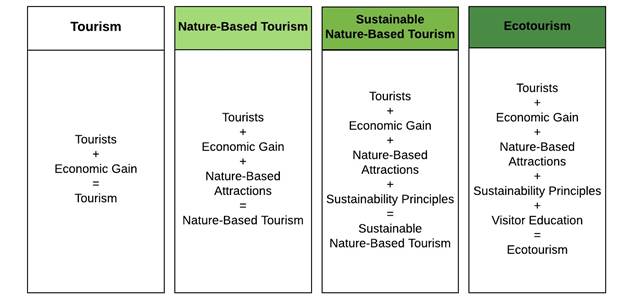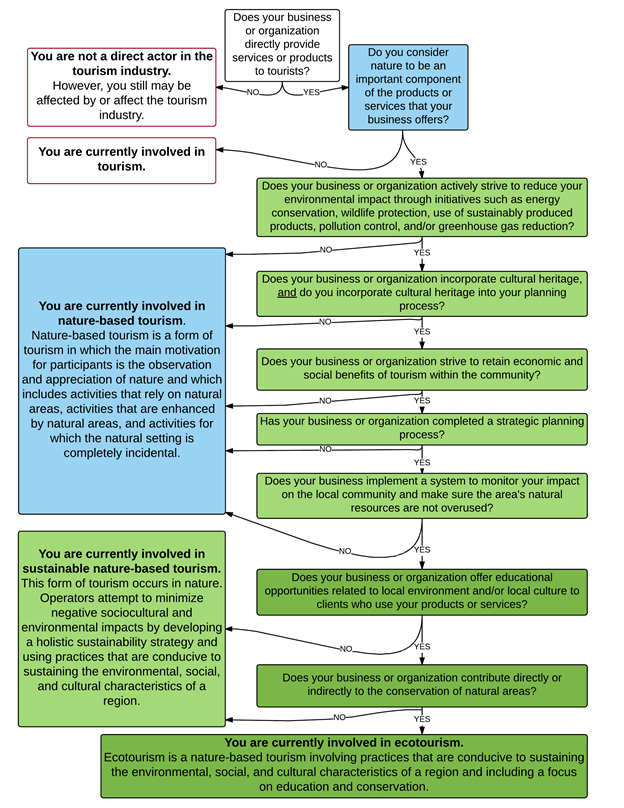 |
October 2017
|
October 2017 // Volume 55 // Number 5 // Tools of the Trade // v55-5tt6
Guiding Local Tourism Entrepreneurs Interested in Ecotourism: A Tool for Extension Facilitators
Abstract
Tourism can stimulate economies, promote cultural preservation, and incentivize environmental conservation. The tourism assessment and planning process described in this article is a tool for facilitating tourism development at the community level by helping entrepreneurs assess the products and services they currently offer, align their current tourism products with best practices for improving their businesses' sustainability, and coordinate efforts to harness the full benefits of sustainable nature-based tourism or ecotourism. Extension educators can use this tool to educate and coordinate tourism entrepreneurs and to encourage them to adopt practices that maximize the cultural, social, economic, and environmental benefits of local tourism by minimizing potential negative impacts.
Introduction
Tourism fuels rural economies by creating jobs, fostering economic growth, and improving local living standards (Akin, Shaw, & Spatz, 2015; Schroeder, 2004; Smith, Davis, & Pike 2010). Often, unique natural and cultural assets of a region drive tourism. Examples discussed in Journal of Extension articles include Wisconsin's Kickapoo River Valley (Akin et al., 2015), Illinois's Shawnee Hills Wine Trail (Smith et al., 2010), the North Dakota plains (Schroeder, 2004), and North Carolina's farm-based tourism (Kline, Cardenas, Leung, & Sanders, 2007). It is important to preserve the landscapes and quality of life that make these communities attractive in the first place (Akin et al., 2015). As Schroeder (2004) highlighted, strong rural tourism economies are heavily reliant on the cultivation of local tourism entrepreneurs. Entrepreneurs can adopt practices to maximize the cultural, social, and environmental benefits associated with the tourism industry while minimizing potential negative impacts on local social and ecological assets. Local tourism entrepreneurs also provide and maintain the link between visitors and the local landscape and culture.
As trusted educators, advisors, and facilitators, Extension professionals are uniquely positioned in the communities where they work to guide entrepreneurs interested in adopting sustainable practices and to facilitate strategic coordination among businesses. The three-phase tourism assessment and planning process outlined in this article is based on the principles of ecotourism and can be used by Extension professionals to facilitate adoption of sustainable tourism practices at the community level. This tool supplements existing tools available to Extension professionals working in the area of tourism throughout the United States (Burkhart-Kriesel & Francis, 2007; Ohnoutka & Hughes, 2002).
Enhancing Community Tourism Through Community Learning and Strategic Planning
A literature review provided the conceptual background for the development of our tourism profiles framework (Figure 1). The framework identifies four general approaches practiced by tourism enterprises and basic criteria for differentiation. We used these categories and general criteria as the basis for creating a process of tourism-related community learning and strategic planning.

The process of using community learning and strategic planning to guide tourism entrepreneurs and facilitate coordination among tourism-related businesses in a community involves three phases:
- assessment of the products and services tourism operators currently offer,
- alignment of the tourism products operators currently offer with best practices for improving the ecological and social sustainability of their businesses, and
- coordination of the different approaches of tourism operators interested in sustainable tourism or ecotourism.
Assessment
We created a self-guided tourism assessment using the four tourism profiles presented in Figure 1. The flow of questions in the assessment tool (Figure 2) reflects a progression from tourism to ecotourism via demonstrable indicators. An entrepreneur self-assesses according to the current characteristics of his or her business and "lands" in a particular profile on the basis of the responses given. The landing pad features detailed information about the profile the entrepreneur matches, why he or she is there, and how that profile looks in different industries.
Figure 2.
Assessment Tool Flowchart

On completing the self-assessment, an entrepreneur receives a detailed explanation of the form of tourism he or she is currently practicing, along with examples in the form of case studies. This result allows the tourism operator to ensure that the tourism product being offered adheres to uniform standards for reaching the target audience. The tool also includes information indicating how an entrepreneur might change to a different profile (e.g., move from nature-based tourism toward ecotourism). In this way, the assessment is both a diagnostic tool and a teaching tool.
The assessment tool addresses the first phase in the larger process of community learning and strategic planning. A participant can then progress through the alignment and coordination phases, with assistance, on the basis of the tourism profile identified during the assessment phase and the goals the participant has for his or her operation (Figure 3).
Figure 3.
Process Diagram

Alignment
During the alignment phase of the process, participants receive guidance as to how they can incorporate more sustainable practices into their tourism operations. Interested participants can review supplemental information developed through a review of commonly accepted ecotourism certification programs in North America so that they can self-identify what more they need to do to convert their current practices. Extension professionals can play an important facilitation role during this phase by helping establish groups of tourism entrepreneurs interested in adopting sustainable practices.
Coordination
Each tourism entrepreneur's actions can positively, or negatively, affect the success of the local tourism industry. At the same time, natural resource degradation is often not the fault of a single tourism operator. It is caused by the collective actions of multiple businesses. For a community to harness the full benefits of sustainable nature-based tourism or ecotourism, it is necessary for stakeholders to engage in a coordinated, strategic, and cooperative effort and have a venue for dialogue and sharing of experiences and ideas. Extension professionals can play the important role of facilitating this process.
We recommend the four steps outlined in Table 1 for coordinating ecotourism stakeholders. Extension professionals can use these steps as guidelines while working with stakeholders who fall into any of the tourism profiles from the assessment tool to develop a shared vision and coordinate their actions (University of Kansas Center for Community Health and Development, n.d.).
| Step number | Step name | Description |
| Step 1 | Networking | Networking is accomplished through formal and nonformal channels, such as
|
| Step 2 | Collective vision | Stakeholders develop a shared vision for tourism with long-term objectives for
|
| Step 3 | Strategy modification | Tourism entrepreneurs combine the collective vision with their current business practices to honestly understand
|
| Step 4 | Continued collaboration | Collaboration and regular meetings are required for stakeholders to
|
Conclusion
The full tourism assessment and planning process tool is available at http://conservancy.umn.edu/handle/11299/187963. We hope that through this collaborative process—assessment, alignment, and coordination—stakeholders gain both tools and knowledge to have a rich dialogue about sustainable tourism and its role in the community. We do not intend to impose a rigid definition of ecotourism or to indicate that ecotourism is something all tourism operators should strive to achieve. Rather we aim to give local tourism entrepreneurs a clear understanding of the tourism products they currently offer and how they might incorporate more sustainable practices into their businesses.
Acknowledgments
The tool described here could not exist without the hospitality, excitement, and engagement of Erin Meier, University of Minnesota's Southeast Sustainable Development Partnership; Joe Deden and the staff of Eagle Bluff Environmental Learning Center; Fillmore County's tourism-based businesses; and our capstone teammates Kristina Werden and Chou Moua.
References
Akin, H., Shaw, B. R., & Spatz, J. T. (2015). Promoting economic development with tourism in rural communities: Destination image and motivation to return or recommend. Journal of Extension, 53(2), Article 2FEA6. Available at: https://www.joe.org/joe/2015april/pdf/JOE_v53_2a6.pdf
Burkhart-Kriesel, C., & Francis, C. (2007). Red carpet service—Linking rural communities to travelers and tourists. Journal of Extension, 45(6), Article 6FEA7. Available at: https://www.joe.org/joe/2007december/a7.php
Kline, C., Cardenas, D., Leung, Y., & Sanders, S. (2007). Sustainable farm tourism: Understanding and managing environmental impacts of visitor activities. Journal of Extension, 45(2), Article 2RIB2. Available at: https://www.joe.org/joe/2007april/rb2.php
Ohnoutka, L., & Hughes, D. W. (2002). Training needs of tourism-based businesses. Journal of Extension, 40(3), Article 3RIB4. Available at: https://www.joe.org/joe/2002june/rb4.php
Schroeder, T. (2004). Motivations of resource-based tourism operators in North Dakota. Journal of Extension, 42(6), Article 6FEA6. Available at: https://www.joe.org/joe/2004december/a6.php
Smith, S., Davis, N., & Pike, J. (2010). Rural tourism development: A case study of the Shawnee Hills Wine Trail in southern Illinois. Journal of Extension, 48(5), Article 5RIB4. Available at: https://www.joe.org/joe/2010october/rb4.php
University of Kansas Center for Community Health and Development. (n.d.). Community tool box—Section 3. Promoting coordination, cooperative agreements, and collaborative agreements among agencies. Retrieved from http://ctb.ku.edu/en/table-of-contents/implement/improving-services/coordination-cooperation-collaboration/main




